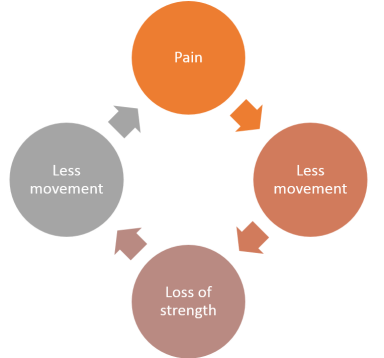Pain is one of the biggest barriers to exercise. Beyond the obvious limits it creates, pain leads to what we call a spiral of inactivity:

Pain makes us move less. Since our body is a “use it to keep it system”, when we use our body less, we lose strength, stamina and mobility, which means movement is more challenging, and so we move less. Over time this inactivity causes stiffness, making movement less comfortable. After a time of less activity we lose muscle mass which means less support for painful joints. Both of these can lead to more pain, and the spiral continues.
The way out of this spiral is to move in order to regain strength, stamina, mobility, function and support around joints. However, what if you have pain when you move? Should you push through pain or listen to it? It feels like a catch 22 and the spiral seems irreversible.
Add to that the all too common “no pain no gain” approach to exercise and the “suffer through in order to get to your goal” approach to weight loss. These can often make pain worse, and leave us believing we need to work through the pain to get to our goal. This discomfort and the frustration it causes can create not only physical but mental barriers to weight loss. It may seem hopeless, but it is not.
The first step is awareness about how our approaches to exercise and to weight loss are making it more difficult to turn the spiral around. Athletes need to push through pain to gain a competitive edge. For health and well-being, pain is your body trying to tell you it cannot tolerate that level of movement right now. Ignore it and it will only “speak” louder. There is no gain in pain.
If you have tried the “get through the first few weeks of a diet until you see results” approach to weight loss, you know it is just not sustainable in the long run. There is no badge of honor for those weeks of suffering through hunger, derivation, sore muscles and fatigue. Not only does it leave us with less motivation to try again next time, it makes our brain look for comfort – and food is a quick and easy source of comfort.
If you goal is to lose weight to feel better, why suffer through exercise in order to feel better? Why not take a direct line to feeling better even before the scale moves? It is possible when you drop the “suffer through” approach and listen to your body with exercise.
This week simply notice your mindset when it comes to exercising for weight loss and the long term effects of it. It helps to keep in mind, weight loss is not a goal. Goals have an end. Sustainable weight loss is a shift in what we do and how we think. Mindfulness helps us make that shift. Next week we will take a closer look at the research on mindfulness and pain to uncover how it can help with exercising when you have pain.
Keep Moving, Be Well,
Janet
These weekly blogs are general guidelines. These guidelines apply to patients who are cleared by a physician for the type of exercise described. Please contact your physician with any concerns or questions. Always report any symptoms associated with exercise, such as pain, irregular heartbeats, and dizziness or fainting, to your physician.
Please share these posts with anyone you know interested in losing weight with or without weight loss surgery. Click here to learn more about the UMass Memorial Weight Center







Pingback: Pain, exercise, and mindfulness – Part 2 | Keep Moving Weekly
Pingback: Pain, exercise and mindfulness – Part 3 | Keep Moving Weekly